gas KIA CARENS RHD 2018 Owners Manual
[x] Cancel search | Manufacturer: KIA, Model Year: 2018, Model line: CARENS RHD, Model: KIA CARENS RHD 2018Pages: 723, PDF Size: 40.94 MB
Page 7 of 723
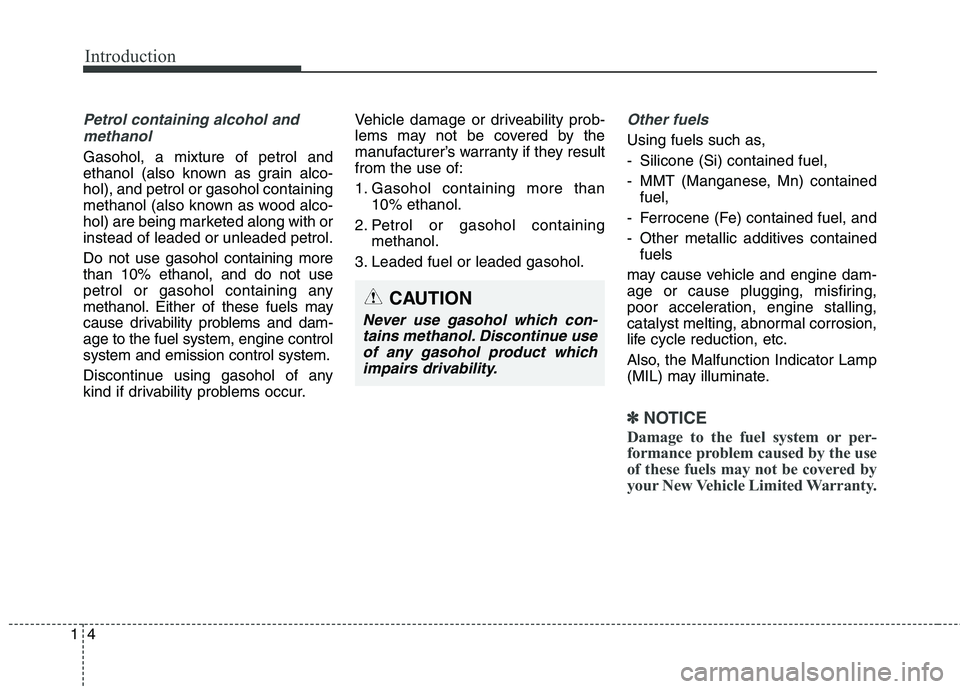
Introduction
4
1
Petrol containing alcohol and
methanol
Gasohol, a mixture of petrol and
ethanol (also known as grain alco-hol), and petrol or gasohol containing
methanol (also known as wood alco-
hol) are being marketed along with orinstead of leaded or unleaded petrol. Do not use gasohol containing more than 10% ethanol, and do not use
petrol or gasohol containing any
methanol. Either of these fuels may
cause drivability problems and dam-age to the fuel system, engine controlsystem and emission control system.
Discontinue using gasohol of any
kind if drivability problems occur. Vehicle damage or driveability prob-
lems may not be covered by the
manufacturer’s warranty if they resultfrom the use of:
1. Gasohol containing more than
10% ethanol.
2. Petrol or gasohol containing methanol.
3. Leaded fuel or leaded gasohol.
Other fuels
Using fuels such as,
- Silicone (Si) contained fuel,
- MMT (Manganese, Mn) contained fuel,
- Ferrocene (Fe) contained fuel, and
- Other metallic additives contained fuels
may cause vehicle and engine dam-
age or cause plugging, misfiring,
poor acceleration, engine stalling,
catalyst melting, abnormal corrosion,
life cycle reduction, etc.
Also, the Malfunction Indicator Lamp
(MIL) may illuminate.
✽✽
NOTICE
Damage to the fuel system or per-
formance problem caused by the use
of these fuels may not be covered by
your New Vehicle Limited Warranty.
CAUTION
Never use gasohol which con- tains methanol. Discontinue useof any gasohol product which impairs drivability.
Page 23 of 723
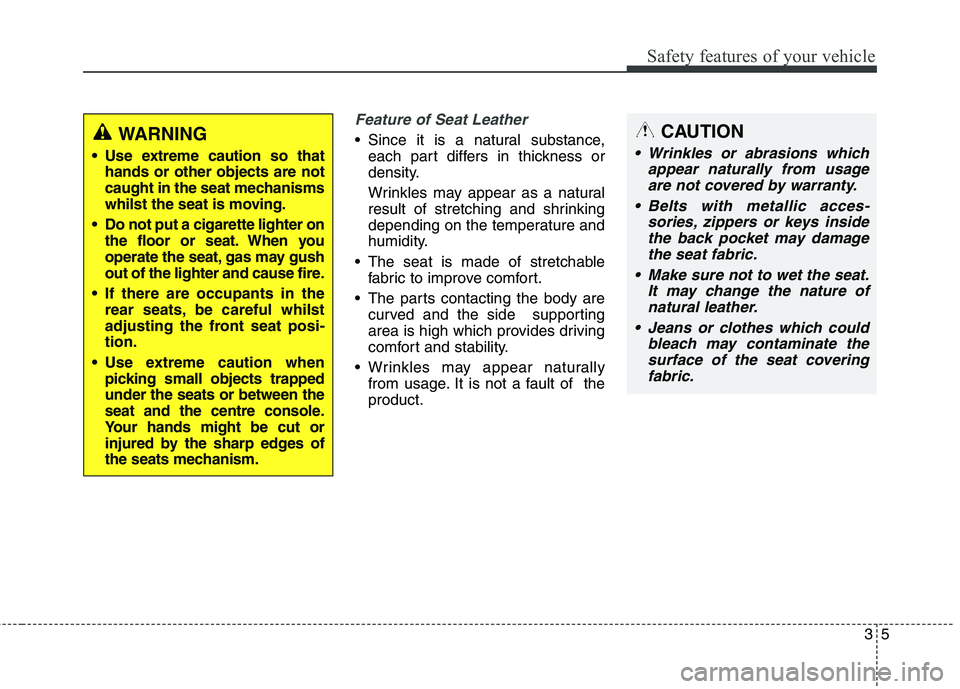
35
Safety features of your vehicle
Feature of Seat Leather
Since it is a natural substance,each part differs in thickness or
density.
Wrinkles may appear as a natural
result of stretching and shrinking
depending on the temperature and
humidity.
The seat is made of stretchable fabric to improve comfort.
The parts contacting the body are curved and the side supporting
area is high which provides driving
comfort and stability.
Wrinkles may appear naturally from usage. It is not a fault of theproduct.WARNING
Use extreme caution so that hands or other objects are not
caught in the seat mechanisms
whilst the seat is moving.
Do not put a cigarette lighter on the floor or seat. When you
operate the seat, gas may gush
out of the lighter and cause fire.
If there are occupants in the rear seats, be careful whilst
adjusting the front seat posi-tion.
Use extreme caution when picking small objects trappedunder the seats or between the
seat and the centre console.
Your hands might be cut or
injured by the sharp edges of
the seats mechanism.CAUTION
Wrinkles or abrasions which
appear naturally from usageare not covered by warranty.
Belts with metallic acces- sories, zippers or keys insidethe back pocket may damagethe seat fabric.
Make sure not to wet the seat. It may change the nature ofnatural leather.
Jeans or clothes which could bleach may contaminate thesurface of the seat coveringfabric.
Page 138 of 723
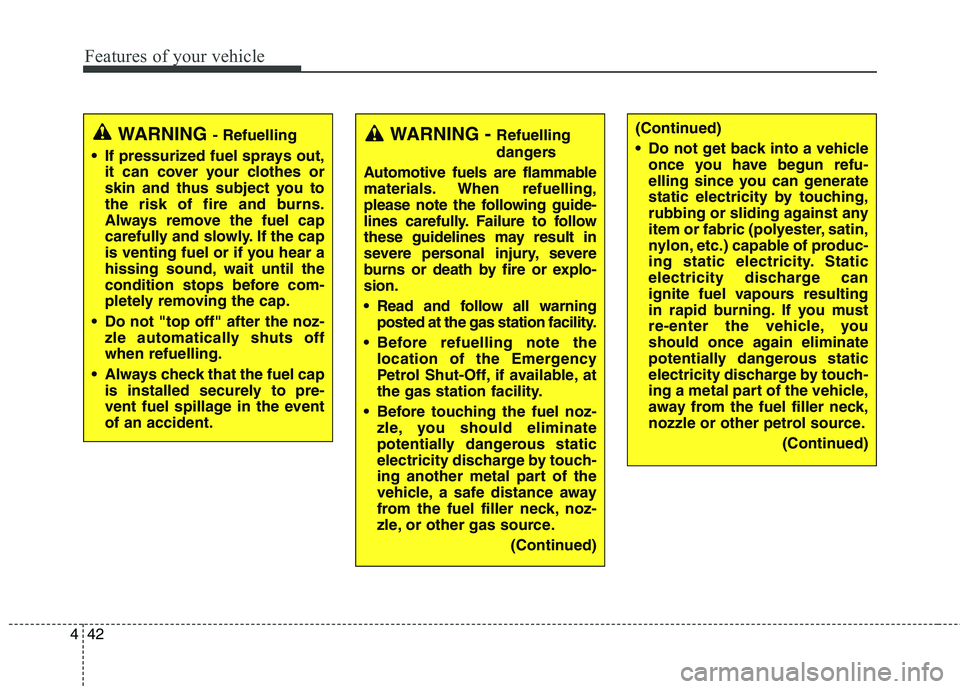
Features of your vehicle
42
4
WARNING - Refuelling
If pressurized fuel sprays out, it can cover your clothes or
skin and thus subject you to
the risk of fire and burns.
Always remove the fuel cap
carefully and slowly. If the cap
is venting fuel or if you hear a
hissing sound, wait until the
condition stops before com-
pletely removing the cap.
Do not "top off" after the noz- zle automatically shuts offwhen refuelling.
Always check that the fuel cap is installed securely to pre-
vent fuel spillage in the eventof an accident.(Continued)
Do not get back into a vehicle once you have begun refu-
elling since you can generate
static electricity by touching,
rubbing or sliding against any
item or fabric (polyester, satin,
nylon, etc.) capable of produc-
ing static electricity. Static
electricity discharge can
ignite fuel vapours resulting
in rapid burning. If you must
re-enter the vehicle, you
should once again eliminate
potentially dangerous static
electricity discharge by touch-
ing a metal part of the vehicle,
away from the fuel filler neck,
nozzle or other petrol source.
(Continued)WARNING - Refuelling
dangers
Automotive fuels are flammable
materials. When refuelling,
please note the following guide-
lines carefully. Failure to follow
these guidelines may result in
severe personal injury, severe
burns or death by fire or explo-sion.
Read and follow all warning posted at the gas station facility.
Before refuelling note the location of the Emergency
Petrol Shut-Off, if available, at
the gas station facility.
Before touching the fuel noz- zle, you should eliminate
potentially dangerous static
electricity discharge by touch-
ing another metal part of the
vehicle, a safe distance away
from the fuel filler neck, noz-
zle, or other gas source.
(Continued)
Page 139 of 723
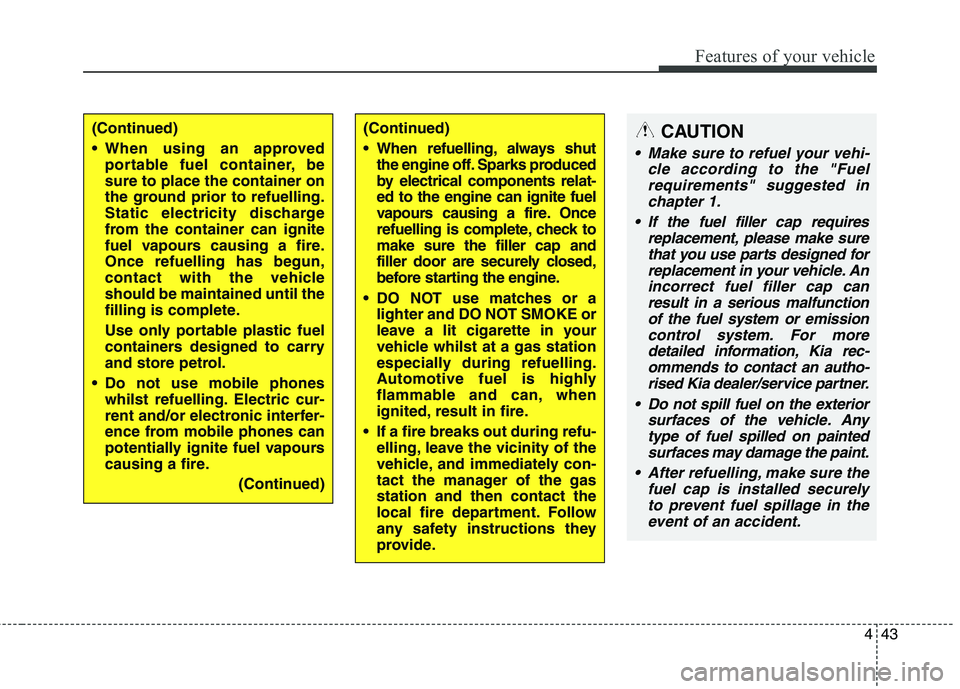
443
Features of your vehicle
(Continued)
When using an approvedportable fuel container, be sure to place the container on
the ground prior to refuelling.
Static electricity discharge
from the container can ignite
fuel vapours causing a fire.Once refuelling has begun,
contact with the vehicleshould be maintained until the
filling is complete.
Use only portable plastic fuel
containers designed to carry
and store petrol.
Do not use mobile phones whilst refuelling. Electric cur-
rent and/or electronic interfer-
ence from mobile phones can
potentially ignite fuel vapours
causing a fire.
(Continued)(Continued)
When refuelling, always shutthe engine off. Sparks produced
by electrical components relat-ed to the engine can ignite fuel
vapours causing a fire. Once
refuelling is complete, check tomake sure the filler cap and
filler door are securely closed,
before starting the engine.
DO NOT use matches or a lighter and DO NOT SMOKE or
leave a lit cigarette in your
vehicle whilst at a gas station
especially during refuelling.
Automotive fuel is highly
flammable and can, when
ignited, result in fire.
If a fire breaks out during refu- elling, leave the vicinity of the
vehicle, and immediately con-
tact the manager of the gasstation and then contact the
local fire department. Follow
any safety instructions they
provide.CAUTION
Make sure to refuel your vehi-
cle according to the "Fuelrequirements" suggested in chapter 1.
If the fuel filler cap requires replacement, please make surethat you use parts designed forreplacement in your vehicle. An incorrect fuel filler cap canresult in a serious malfunctionof the fuel system or emission control system. For moredetailed information, Kia rec-ommends to contact an autho- rised Kia dealer/service partner.
Do not spill fuel on the exterior surfaces of the vehicle. Anytype of fuel spilled on paintedsurfaces may damage the paint.
After refuelling, make sure the fuel cap is installed securelyto prevent fuel spillage in theevent of an accident.
Page 211 of 723
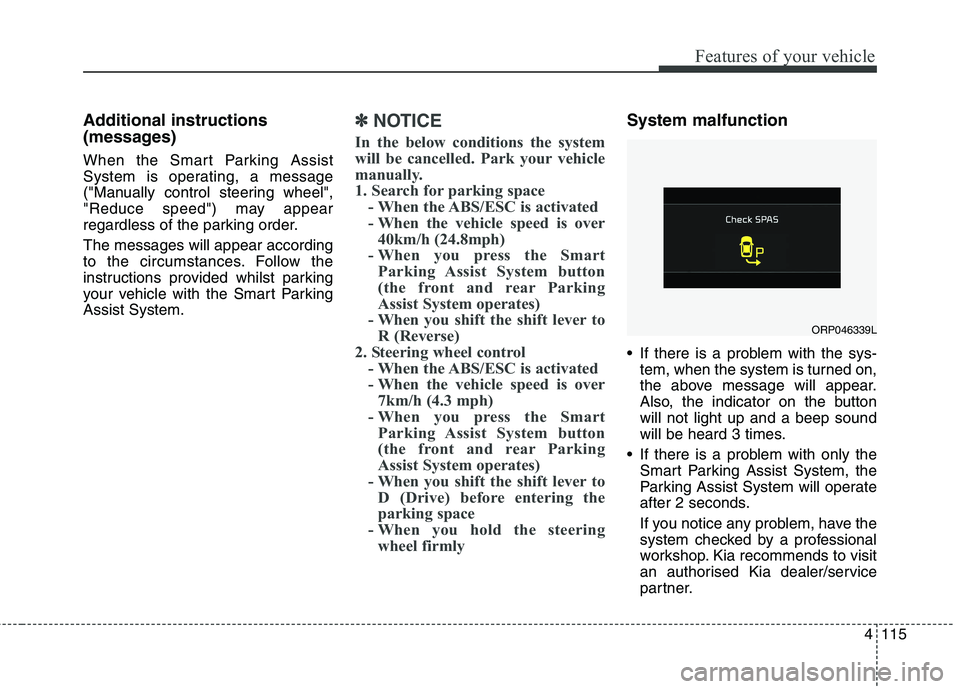
4115
Features of your vehicle
Additional instructions
(messages)
When the Smart Parking Assist
System is operating, a message
("Manually control steering wheel",
"Reduce speed") may appear
regardless of the parking order. The messages will appear according
to the circumstances. Follow the
instructions provided whilst parking
your vehicle with the Smart ParkingAssist System.✽✽NOTICE
In the below conditions the system
will be cancelled. Park your vehicle
manually.
1. Search for parking space - When the ABS/ESC is activated
- When the vehicle speed is over40km/h (24.8mph)
- When you press the Smart Parking Assist System button
(the front and rear Parking
Assist System operates)
- When you shift the shift lever to R (Reverse)
2. Steering wheel control - When the ABS/ESC is activated
- When the vehicle speed is over7km/h (4.3 mph)
- When you press the Smart Parking Assist System button
(the front and rear Parking
Assist System operates)
- When you shift the shift lever to D (Drive) before entering the
parking space
- When you hold the steering wheel firmlySystem malfunction
If there is a problem with the sys- tem, when the system is turned on,
the above message will appear.
Also, the indicator on the buttonwill not light up and a beep sound
will be heard 3 times.
If there is a problem with only the Smart Parking Assist System, the
Parking Assist System will operate
after 2 seconds.
If you notice any problem, have the
system checked by a professional
workshop. Kia recommends to visit
an authorised Kia dealer/service
partner.
ORP046339L
Page 438 of 723
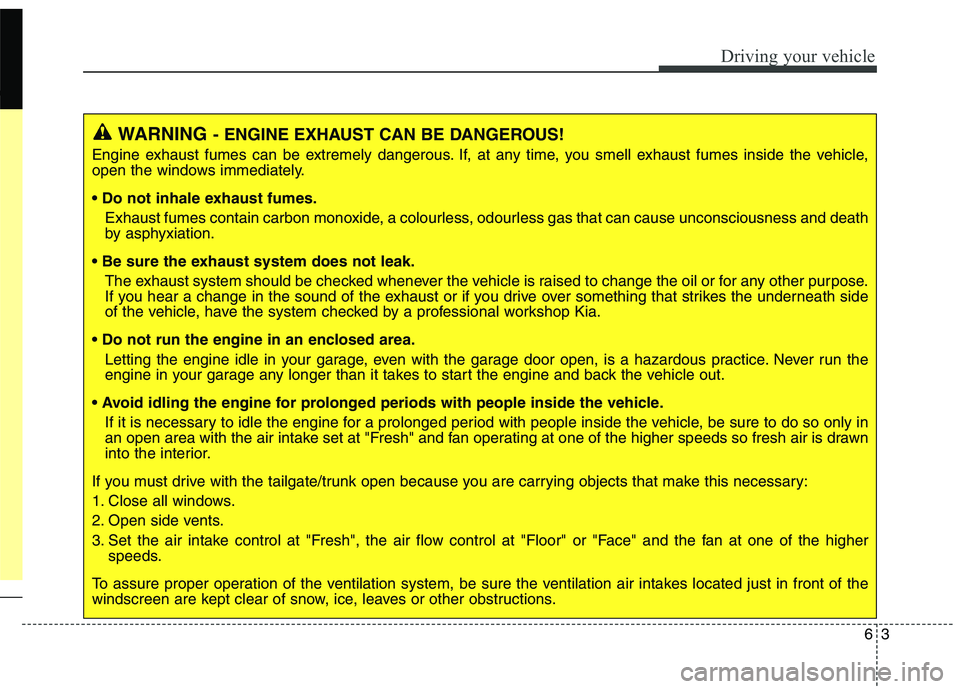
63
Driving your vehicle
WARNING- ENGINE EXHAUST CAN BE DANGEROUS!
Engine exhaust fumes can be extremely dangerous. If, at any time, you smell exhaust fumes inside the vehicle,
open the windows immediately.
• Do not inhale exhaust fumes.
Exhaust fumes contain carbon monoxide, a colourless, odourless gas that can cause unconsciousness and death
by asphyxiation.
The exhaust system should be checked whenever the vehicle is raised to change the oil or for any other purpose.
If you hear a change in the sound of the exhaust or if you drive over something that strikes the underneath side
of the vehicle, have the system checked by a professional workshop Kia.
Letting the engine idle in your garage, even with the garage door open, is a hazardous practice. Never run the
engine in your garage any longer than it takes to start the engine and back the vehicle out.
If it is necessary to idle the engine for a prolonged period with people inside the vehicle, be sure to do so only in
an open area with the air intake set at "Fresh" and fan operating at one of the higher speeds so fresh air is drawn
into the interior.
If you must drive with the tailgate/trunk open because you are carrying objects that make this necessary:
1. Close all windows.
2. Open side vents.
3. Set the air intake control at "Fresh", the air flow control at "Floor" or "Face" and the fan at one of the higher speeds.
To assure proper operation of the ventilation system, be sure the ventilation air intakes located just in front of the
windscreen are kept clear of snow, ice, leaves or other obstructions.
Page 555 of 723
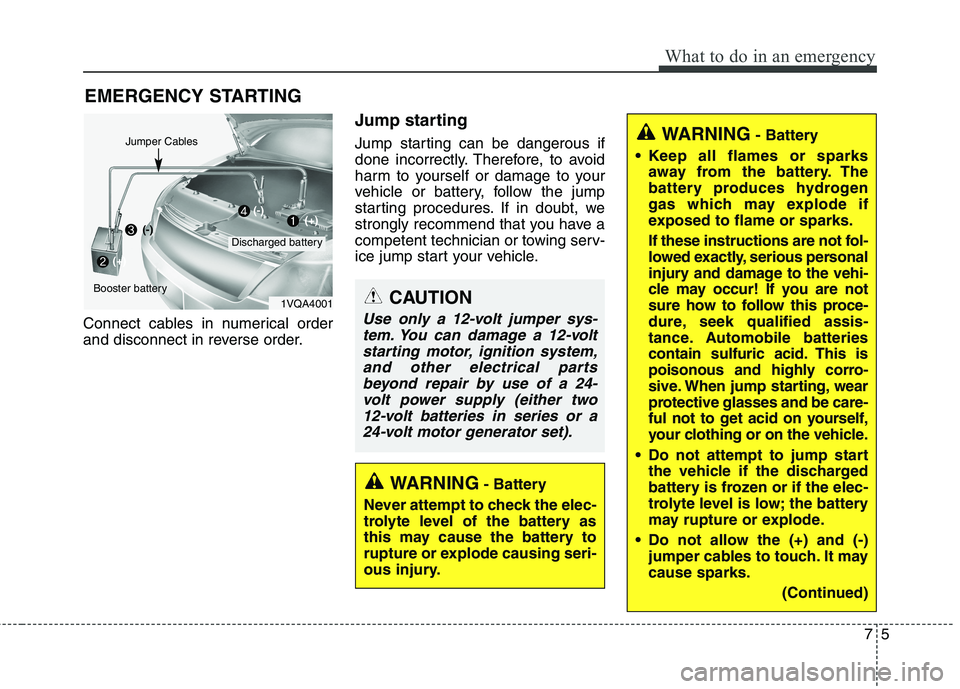
75
What to do in an emergency
EMERGENCY STARTING
Connect cables in numerical order
and disconnect in reverse order. Jump starting
Jump starting can be dangerous if
done incorrectly. Therefore, to avoid
harm to yourself or damage to your
vehicle or battery, follow the jump
starting procedures. If in doubt, we
strongly recommend that you have a
competent technician or towing serv-
ice jump start your vehicle.
CAUTION
Use only a 12-volt jumper sys-
tem. You can damage a 12-voltstarting motor, ignition system, and other electrical partsbeyond repair by use of a 24-volt power supply (either two 12-volt batteries in series or a24-volt motor generator set).
WARNING - Battery
Never attempt to check the elec-
trolyte level of the battery as
this may cause the battery to
rupture or explode causing seri-
ous injury.
1VQA4001
Discharged battery
Jumper Cables
Booster battery(-)
(+)
(+)(-)
WARNING - Battery
• Keep all flames or sparks away from the battery. The
battery produces hydrogen
gas which may explode if
exposed to flame or sparks.
If these instructions are not fol-
lowed exactly, serious personal
injury and damage to the vehi-
cle may occur! If you are not
sure how to follow this proce-
dure, seek qualified assis-
tance. Automobile batteries
contain sulfuric acid. This is
poisonous and highly corro-
sive. When jump starting, wear
protective glasses and be care-
ful not to get acid on yourself,
your clothing or on the vehicle.
Do not attempt to jump start the vehicle if the discharged
battery is frozen or if the elec-
trolyte level is low; the battery
may rupture or explode.
Do not allow the (+) and (-) jumper cables to touch. It maycause sparks.
(Continued)
Page 600 of 723
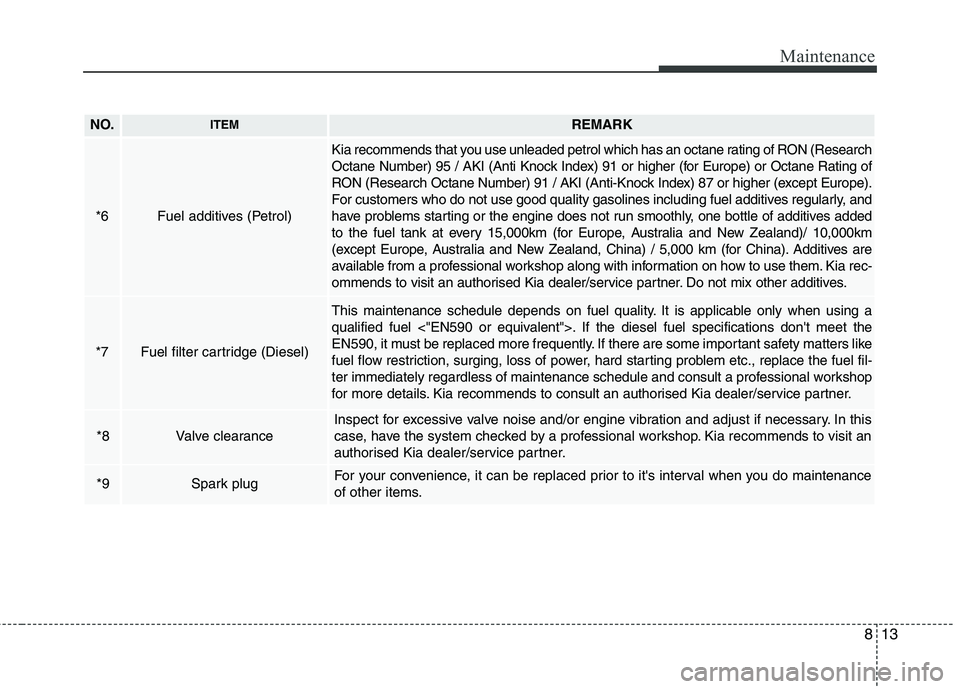
813
Maintenance
NO.ITEMREMARK
*6Fuel additives (Petrol)
Kia recommends that you use unleaded petrol which has an octane rating of RON (Research
Octane Number) 95 / AKI (Anti Knock Index) 91 or higher (for Europe) or Octane Rating of
RON (Research Octane Number) 91 / AKI (Anti-Knock Index) 87 or higher (except Europe).
For customers who do not use good quality gasolines including fuel additives regularly, and
have problems starting or the engine does not run smoothly, one bottle of additives added
to the fuel tank at every 15,000km (for Europe, Australia and New Zealand)/ 10,000km
(except Europe, Australia and New Zealand, China) / 5,000 km (for China). Additives are
available from a professional workshop along with information on how to use them. Kia rec-
ommends to visit an authorised Kia dealer/service partner. Do not mix other additives.
*7Fuel filter cartridge (Diesel)
This maintenance schedule depends on fuel quality. It is applicable only when using a
qualified fuel <"EN590 or equivalent">. If the diesel fuel specifications don't meet the
EN590, it must be replaced more frequently. If there are some important safety matters like
fuel flow restriction, surging, loss of power, hard starting problem etc., replace the fuel fil-
ter immediately regardless of maintenance schedule and consult a professional workshop
for more details. Kia recommends to consult an authorised Kia dealer/service partner.
*8Valve clearance
Inspect for excessive valve noise and/or engine vibration and adjust if necessary. In this
case, have the system checked by a professional workshop. Kia recommends to visit an
authorised Kia dealer/service partner.
*9Spark plugFor your convenience, it can be replaced prior to it's interval when you do maintenance
of other items.
Page 607 of 723
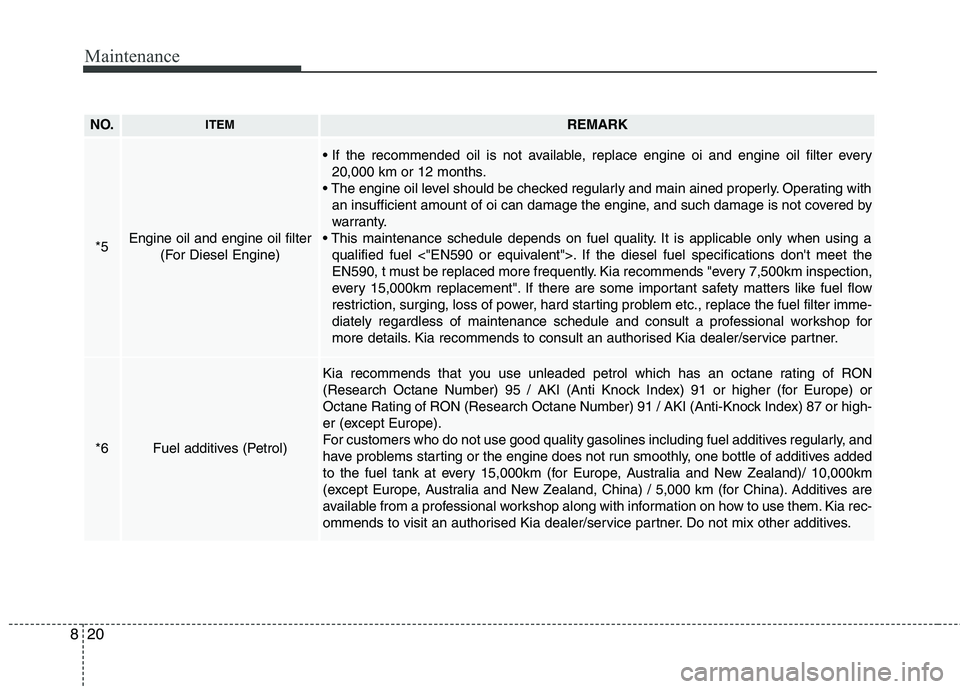
Maintenance
20
8
NO.ITEMREMARK
*5Engine oil and engine oil filter
(For Diesel Engine)
20,000 km or 12 months.
Operating with an insufficient amount of oi can damage the engine, and such damage is not covered by
warranty.
It is applicable only when using a qualified fuel <"EN590 or equivalent">. If the diesel fuel specifications don't meet the
EN590, t must be replaced more frequently. Kia recommends "every 7,500km inspection,
every 15,000km replacement". If there are some important safety matters like fuel flow
restriction, surging, loss of power, hard starting problem etc., replace the fuel filter imme-
diately regardless of maintenance schedule and consult a professional workshop for
more details. Kia recommends to consult an authorised Kia dealer/service partner.
*6Fuel additives (Petrol)
Kia recommends that you use unleaded petrol which has an octane rating of RON
(Research Octane Number) 95 / AKI (Anti Knock Index) 91 or higher (for Europe) or
Octane Rating of RON (Research Octane Number) 91 / AKI (Anti-Knock Index) 87 or high-
er (except Europe).
For customers who do not use good quality gasolines including fuel additives regularly, and
have problems starting or the engine does not run smoothly, one bottle of additives added
to the fuel tank at every 15,000km (for Europe, Australia and New Zealand)/ 10,000km
(except Europe, Australia and New Zealand, China) / 5,000 km (for China). Additives are
available from a professional workshop along with information on how to use them. Kia rec-
ommends to visit an authorised Kia dealer/service partner. Do not mix other additives.
Page 635 of 723
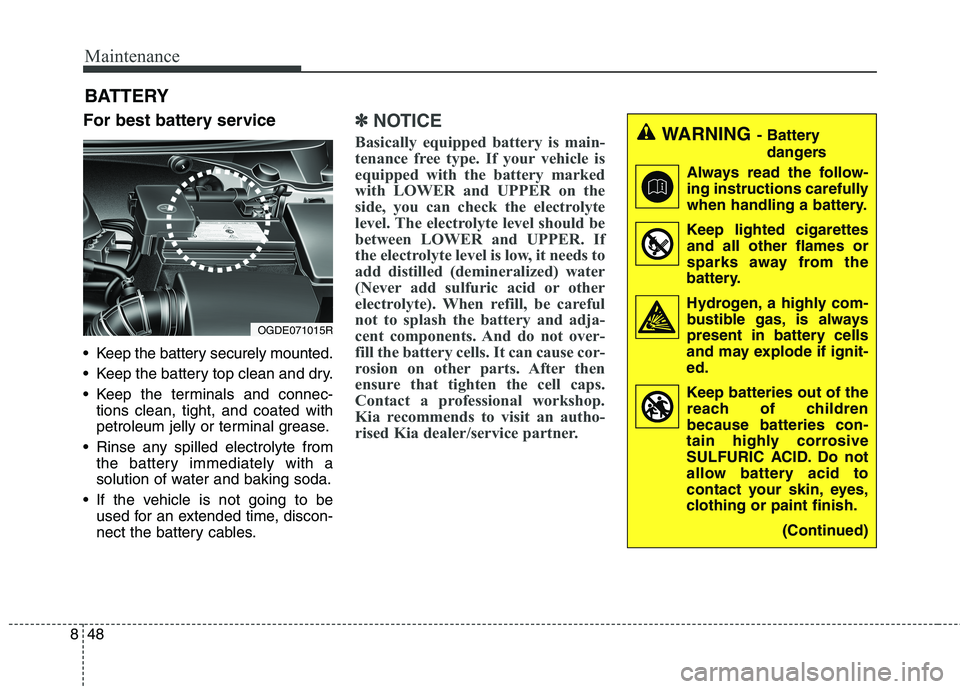
Maintenance
48
8
BATTERY
For best battery service
Keep the battery securely mounted.
Keep the battery top clean and dry.
Keep the terminals and connec- tions clean, tight, and coated with
petroleum jelly or terminal grease.
Rinse any spilled electrolyte from the battery immediately with a
solution of water and baking soda.
If the vehicle is not going to be used for an extended time, discon-
nect the battery cables.
✽✽ NOTICE
Basically equipped battery is main-
tenance free type. If your vehicle is
equipped with the battery marked
with LOWER and UPPER on the
side, you can check the electrolyte
level. The electrolyte level should be
between LOWER and UPPER. If
the electrolyte level is low, it needs to
add distilled (demineralized) water
(Never add sulfuric acid or other
electrolyte). When refill, be careful
not to splash the battery and adja-
cent components. And do not over-
fill the battery cells. It can cause cor-
rosion on other parts. After then
ensure that tighten the cell caps.
Contact a professional workshop.
Kia recommends to visit an autho-
rised Kia dealer/service partner.WARNING - Battery
dangers
Always read the follow-
ing instructions carefully
when handling a battery.
Keep lighted cigarettes and all other flames or
sparks away from the
battery.
Hydrogen, a highly com- bustible gas, is always
present in battery cells
and may explode if ignit-ed.
Keep batteries out of the reach of children because batteries con-
tain highly corrosive
SULFURIC ACID. Do not
allow battery acid to
contact your skin, eyes,
clothing or paint finish.
(Continued)
OGDE071015R